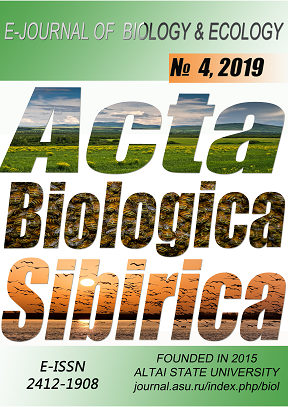Abstract
The article considers the results of morphometric analysis of Trapa natans fruits from different populations in Altai Krai. It estimates the level of the fruits polymorphism within and among the populations. The hydrological features of water bodies as water caltrop habitats are assessed.
References
Arbusova GA, Gorbunova AI, Chepinoga V.V. 2019. Rogulʹnik plavayushchiy (Trapa natans L., Lythraceae) v Irkutskoy oblasti. Vestnik Buryatskogo gosudarstvennogo universiteta 1: 29–36.
Berestenko EN, Kislov DE. 2013. Indikatsiya predstaviteley roda Trapa L. Primorskogo kraya po morfometri cheskim priznakam plodov. Vestnik KrasGAU 11: 94–100.
Didukh AYa. 2011. Vodyanoy orekh plavayushchiy – Trapa natans L. s. l. i neobkhodimyye mery dlya yego sokhraneniya v Ukraine. Byulleten' Gosudarstvennogo Nikitskiy botanicheskiy sada 102: 20–26.
Dodd LL, Rybicki N, Thum R, Kadono Y, Ingram K. 2019. Genetic and Morphological Differences between Water Chestnut (Myrtales: Lythraceae: Trapa) Populations in the Northeastern United States, Japan, and South Africa. The US Army Engineer Research and Development Center 3: 37.
Durnikin DA. 2003. Semeystvo Trapaceae. Opredelitel' rasteniy Altayskogo kraya, Barnaul: Altai State University.
Flerov AF. 1925. Sistematika i botanicheskaya geografiya roda Trapa L. Izvestiya Glavnogo Botanicheskogo sada RSFSR 24: 13–45.
Phartyal SS, Rosbakh S, Poschlod P. 2018. Seed germination ecology in Trapa natans L., a widely distributed freshwater macrophyte. Aquatic Botany 147: 18–23. Doi: 10.1016/j.aquabot.2018.02.001
Silanteva MM. 2013. Konspekt flory Altayskogo kraya. Barnaul: Altai State Univesity.
Tzvelev NN. 1993. O rode Trapa L. (Trapaceae) v Vostochnoy Yevrope i Severnoy Azii. Novosti sistematiki vysshikh rasteniy 29: 99–107.
Vasil'yev VN. 1949. Semeystvo Vodyanyye orekhi Hydrocaryaceae Raimann. Flora SSSR 15: 637–662.
Vasilyev VN. 1960. Vodyanoy orekh i perspektivy yego kul'tury v SSSR. Moscow-Leningrad.
Vlasova NV. 1996. Semeystvo Trapaceae. Flora Sibiri 10:120.
Acta Biologica Sibirica is a golden publisher, as we allow self-archiving, but most importantly we are fully transparent about your rights.
Authors may present and discuss their findings ahead of publication: at biological or scientific conferences, on preprint servers, in public databases, and in blogs, wikis, tweets, and other informal communication channels.
ABS allows authors to deposit manuscripts (currently under review or those for intended submission to ABS) in non-commercial, pre-print servers such as ArXiv.
Authors who publish with this journal agree to the following terms:
- Authors retain copyright and grant the journal right of first publication with the work simultaneously licensed under a Creative Commons Attribution License (CC BY 4.0) that allows others to share the work with an acknowledgement of the work's authorship and initial publication in this journal.
- Authors are able to enter into separate, additional contractual arrangements for the non-exclusive distribution of the journal's published version of the work (e.g., post it to an institutional repository or publish it in a book), with an acknowledgement of its initial publication in this journal.
- Authors are permitted and encouraged to post their work online (e.g., in institutional repositories or on their website) prior to and during the submission process, as it can lead to productive exchanges, as well as earlier and greater citation of published work (See The Effect of Open Access).





